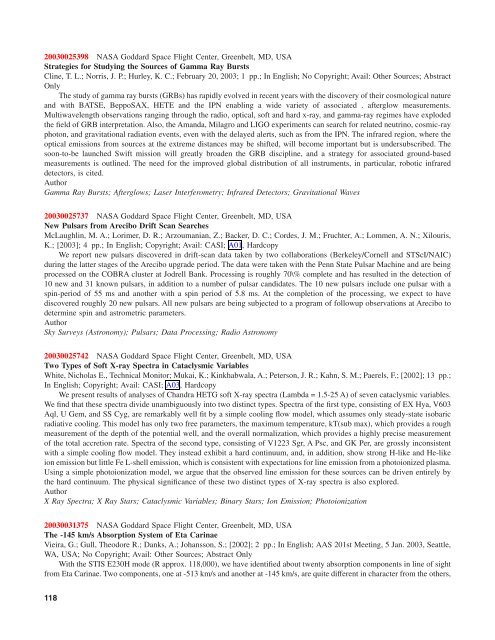Create successful ePaper yourself
Turn your PDF publications into a flip-book with our unique Google optimized e-Paper software.
20030025398 NASA Goddard Space Flight Center, Greenbelt, MD, USA<br />
Strategies for Studying the Sources of Gamma Ray Bursts<br />
Cline, T. L.; Norris, J. P.; Hurley, K. C.; February 20, 2003; 1 pp.; In English; No Copyright; Avail: Other Sources; Abstract<br />
Only<br />
The study of gamma ray bursts (GRBs) has rapidly evolved in recent years with the discovery of their cosmological nature<br />
and with BATSE, BeppoSAX, HETE and the IPN enabling a wide variety of associated . afterglow measurements.<br />
Multiwavelength observations ranging through the radio, optical, soft and hard x-ray, and gamma-ray regimes have exploded<br />
the field of GRB interpretation. Also, the Amanda, Milagro and LIGO experiments can search for related neutrino, cosmic-ray<br />
photon, and gravitational radiation events, even with the delayed alerts, such as from the IPN. The infrared region, where the<br />
optical emissions from sources at the extreme distances may be shifted, will become important but is undersubscribed. The<br />
soon-to-be launched Swift mission will greatly broaden the GRB discipline, and a strategy for associated ground-based<br />
measurements is outlined. The need for the improved global distribution of all instruments, in particular, robotic infrared<br />
detectors, is cited.<br />
Author<br />
Gamma Ray Bursts; Afterglows; Laser Interferometry; Infrared Detectors; Gravitational Waves<br />
20030025737 NASA Goddard Space Flight Center, Greenbelt, MD, USA<br />
New Pulsars from Arecibo Drift Scan Searches<br />
McLaughlin, M. A.; Lorimer, D. R.; Arzoumanian, Z.; Backer, D. C.; Cordes, J. M.; Fruchter, A.; Lommen, A. N.; Xilouris,<br />
K.; [2003]; 4 pp.; In English; Copyright; Avail: CASI; A01, Hardcopy<br />
We report new pulsars discovered in drift-scan data taken by two collaborations (Berkeley/Cornell and STScI/NAIC)<br />
during the latter stages of the Arecibo upgrade period. The data were taken with the Penn State Pulsar Machine and are being<br />
processed on the COBRA cluster at Jodrell Bank. Processing is roughly 70\% complete and has resulted in the detection of<br />
10 new and 31 known pulsars, in addition to a number of pulsar candidates. The 10 new pulsars include one pulsar with a<br />
spin-period of 55 ms and another with a spin period of 5.8 ms. At the completion of the processing, we expect to have<br />
discovered roughly 20 new pulsars. All new pulsars are being subjected to a program of followup observations at Arecibo to<br />
determine spin and astrometric parameters.<br />
Author<br />
Sky Surveys (Astronomy); Pulsars; Data Processing; Radio Astronomy<br />
20030025742 NASA Goddard Space Flight Center, Greenbelt, MD, USA<br />
Two Types of Soft X-ray Spectra in Cataclysmic Variables<br />
White, Nicholas E., Technical Monitor; Mukai, K.; Kinkhabwala, A.; Peterson, J. R.; Kahn, S. M.; Paerels, F.; [2002]; 13 pp.;<br />
In English; Copyright; Avail: CASI; A03, Hardcopy<br />
We present results of analyses of Chandra HETG soft X-ray spectra (Lambda = 1.5-25 A) of seven cataclysmic variables.<br />
We find that these spectra divide unambiguously into two distinct types. Spectra of the first type, consisting of EX Hya, V603<br />
Aql, U Gem, and SS Cyg, are remarkably well fit by a simple cooling flow model, which assumes only steady-state isobaric<br />
radiative cooling. This model has only two free parameters, the maximum temperature, kT(sub max), which provides a rough<br />
measurement of the depth of the potential well, and the overall normalization, which provides a highly precise measurement<br />
of the total accretion rate. Spectra of the second type, consisting of V1223 Sgr, A Psc, and GK Per, are grossly inconsistent<br />
with a simple cooling flow model. They instead exhibit a hard continuum, and, in addition, show strong H-like and He-like<br />
ion emission but little Fe L-shell emission, which is consistent with expectations for line emission from a photoionized plasma.<br />
Using a simple photoionization model, we argue that the observed line emission for these sources can be driven entirely by<br />
the hard continuum. The physical significance of these two distinct types of X-ray spectra is also explored.<br />
Author<br />
X Ray Spectra; X Ray Stars; Cataclysmic Variables; Binary Stars; Ion Emission; Photoionization<br />
20030031375 NASA Goddard Space Flight Center, Greenbelt, MD, USA<br />
The -145 km/s Absorption System of Eta Carinae<br />
Vieira, G.; Gull, Theodore R.; Danks, A.; Johansson, S.; [2002]; 2 pp.; In English; AAS 201st Meeting, 5 Jan. 2003, Seattle,<br />
WA, USA; No Copyright; Avail: Other Sources; Abstract Only<br />
With the STIS E230H mode (R approx. 118,000), we have identified about twenty absorption components in line of sight<br />
from Eta Carinae. Two components, one at -513 km/s and another at -145 km/s, are quite different in character from the others,<br />
118
















